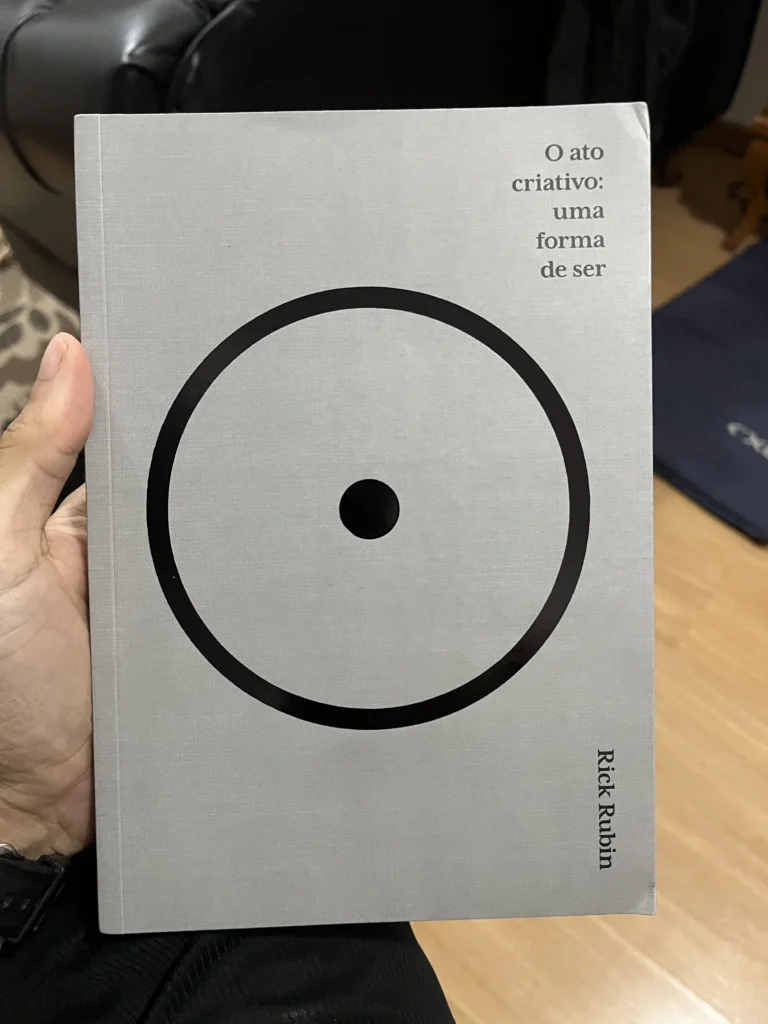The Main Teachings from the Book “The Creative Act” by Rick Rubin
What should you expect from this legendary figure? Here’s how Rick Rubin defined art in his book, The Creative Act.
When you see the man in the photo, you probably wouldn’t guess that he:
- Produced for Lady Gaga, Metallica, Linkin Park, and Johnny Cash.
- Was a vegan for 20 years.
- Doesn’t play any musical instruments.
- Has a net worth of $300 million and prefers to walk barefoot.
But this book isn’t about him. It’s about the ideas he conveys through his words. Rick Rubin himself states that he gets paid (and handsomely) for his ability to discern what is good and to help the artist find it within their own creative process.
Regardless, I have never read anything quite like this book before. He managed to put into words his vision of what art is: how it occurs both within and around us, and how we can tap into that marvelous energy and transform it into… a finished Work.
Here are a few of the lessons that I took away from the book.
1. Your entire life is a form of self-expression.
This is a powerful concept. If we stop to pay attention, we see the world is in constant motion. Flowers bloom, rain falls, the sun rises and sets, people go to work. Every day, we express ourselves in countless ways, often unconsciously.
Therefore, everything you do—and even what you don’t do—is ultimately a message.
2. Certain ideas have their own time to arrive, and they find a way to be expressed through us.
Before starting this website, I thought about it for a long time. But I didn’t know where or how to release the ideas I had inside me. The internet can be a cruel place for new ideas; people often resist what isn’t obvious.
However, I wanted to create something different. Something with my own identity. I didn’t want to copy anything or anyone. Eighteen months later, the idea finally came.
3. The ability to look deeply is the root of creativity—to see beyond the mundane and grasp what might otherwise be invisible.
Details are so fundamental they shouldn’t even be called “details.” The ability to see beauty, purpose, and meaning in things, people, and events is what makes us human.
It’s vital for all of us to have time to do nothing—to embrace absolute idleness. We need that space to connect the dots within our minds.
These were just a few of the teachings I absorbed from the book. I don’t want to list all my notes (I took 95 of them!). Instead, let’s change the angle…
My Perspective on The Creative Act
Act 1 – Comprehension
First, I want to tell you that this book focuses heavily on how to feel. Talking about this is difficult. Feeling is subjective, rare, and unique.
In this first part of the book, Rick teaches us to first understand this feeling we have within us. This purity, this voice, this desire to express ourselves to the world.
You know that restlessness? That urge to shout to everyone that you have something meaningful to show them? Yes, that’s it!
I spent the last six years of my life accumulating knowledge and wisdom because I wanted to express myself somehow and add value to people’s lives. But it had to be on my own terms, with my own identity.
It took me eighteen months to finally do it. Why? Because I wasn’t ready. I had to learn to listen to myself, to that inner voice. I had to understand the bigger picture and what this voice was truly trying to tell me. The will to help was there. The will to act was there. But I was missing the “how” and “where.”
- Writing
- Audio
- Video
- An App
- Drawing
There are so many ways to express your art online. But what should you create? What could be relevant in someone’s life? How can I make a positive impact?
I know… we all have this doubt.
Rick Rubin teaches us to “let it flow.” And that is the easy-but-hard part.
Why?
There are millions of possibilities, but we have to make a choice. And it’s precisely at that moment of choice that… we freeze.
We freeze because we think too much. What will people think? Will it be good enough? How many views or likes will my art get?
To be completely honest with you: don’t worry about any of that. Set a bold goal. Be consistent and surrender to the process.
I’ve been creating things for the internet for eighteen months now. I can tell you I’ve written over 500 articles and made over 1,000 social media posts.
And you know what I learned? After a while, you have to stop caring so much about the numbers. Focus on your art.
Create your art, polish it, improve it, refine it even more, and then show it to the world.
I have been insulted, hated, and ridiculed for many posts I’ve made. I always treated everyone with politeness and never reacted. A simple, “You’re right,” solves everything.
Just start, get better, and keep going.
Act 2 – Action
They will criticize you if you try. They will criticize you if you don’t. Since you’ll be criticized no matter what, you might as well try.
What difference will it make? At least you’ve taken a step and added a brick to the wall. You’ll add another tomorrow, and the day after. Soon, your castle will stand tall, and your critics will either vanish or try to copy you.
In this second part of the book, which I’ll call “Action,” Rick Rubin emphasizes that there is no magic formula or straight path.
You will only know what to do (or think you know) after you begin. And that’s the beauty of life. So many people want ready-made formulas and miraculous strategies for their businesses.
That’s why a gigantic digital market has been created, filled with expensive products and services that, in reality, don’t solve your problem.
I can tell you this for sure: I’ve bought books, courses, and services too. But nothing in life has helped me more than good old intuition.
Try standing in the shower and letting the water fall on your head with your eyes closed. Try sitting by the ocean with your eyes closed. I dare you to lie in the grass with your eyes closed, just feeling the wind in your hair and on your face.
And do you know why I suggested “with your eyes closed” in every experience?
Because some things in life need to be felt. For these beautiful moments, closing your eyes allows for a deeper connection with your soul.
You don’t need AI to know if your company is doing well, you don’t need a smartwatch to know if you slept well, and you definitely don’t need the most expensive phone or computer to write, code, or create your best art.
Definitely not. I’m writing this very text lying in bed on my phone, with my wife and my poodle beside me. Obviously, I’ll review it on the computer, but tools shouldn’t stop you. And they shouldn’t stop your art.
Act 3 – The Work
To conclude this piece, let’s talk about legacy. In various parts of the book, Rubin teaches us that we need to find ourselves, create, and then find new ways to create more and better work, to finally arrive here.
To stand the test of time, a work of art aims to mark our passage on this Earth. It is the message in the form of music, books, texts, videos, paintings, photos, or apps.
Whatever the form, your job as an artist is to create a channel—the space and the time—to let your art flow through you and reach completion.
So, I’ll be brief. Because at this very moment, as I write, I am creating a new piece of my own work. I hope you’ve grasped the message and will now close this text to start building yours…
Until next time!
Victoria Concordia Crescit


